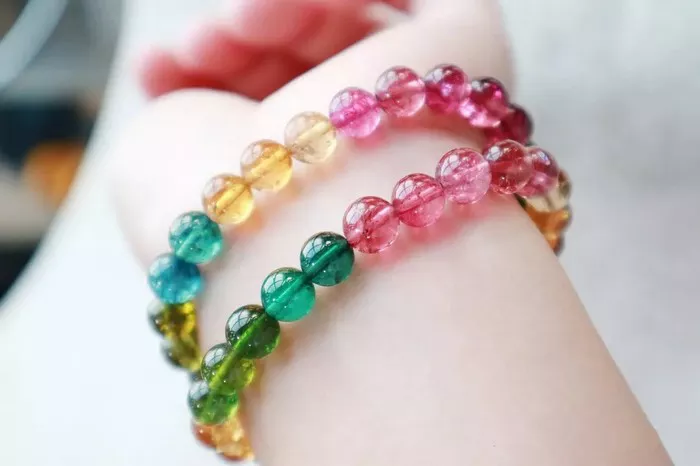Tourmaline, a captivating gemstone that has been treasured for centuries, is a true wonder of nature. Known for its mesmerizing colors and unique crystal structure, tourmaline captures the imagination with its endless variations and captivating allure. In this article, we delve into the world of tourmaline, exploring its appearance, properties, and the reasons behind its enduring popularity.
The Splendor of Tourmaline
Tourmaline is a complex borosilicate mineral that belongs to a diverse family of gemstones. It exhibits a remarkable range of colors, making it one of the most versatile gemstones in existence. From vibrant greens and blues to luscious pinks and reds, and even rare color combinations, tourmaline offers an astonishing palette of hues to suit every taste.
Color Varieties: A Kaleidoscope of Delights
One of the most intriguing aspects of tourmaline is its ability to display multiple colors within a single specimen. This remarkable phenomenon, known as “pleochroism,” adds an extra dimension of beauty to the gemstone. As light passes through the crystal, different colors become visible depending on the angle of observation. This play of colors makes each tourmaline gemstone a unique work of art.
Tourmaline can be found in various shades of green, ranging from pale mint to deep forest green. One particularly prized variation is the chrome tourmaline, which boasts a rich emerald green hue due to traces of chromium. Other popular green shades include verdelite, a bright green variety, and tsavorite, an intense green garnet-like stone.
For those enchanted by the ocean’s depths, blue tourmalines are a perfect choice. Indicolite, with its vivid blue tones reminiscent of the sea, captures the imagination and evokes a sense of tranquility. Paraiba tourmaline, discovered in Brazil in the 1980s, is renowned for its electrifying neon blue and green shades. Its rarity and exceptional color make it highly sought after by collectors and connoisseurs alike.
Tourmaline also showcases an array of captivating pink and red hues. Rubellite, with its deep reddish-pink tones, exudes passion and femininity. Watermelon tourmaline, aptly named for its resemblance to the fruit, displays a delightful combination of pink, green, and white zones. These unique gemstones are often cut into slices to showcase their stunning internal patterns, adding a touch of whimsy to any jewelry piece.
Yellow tourmalines, ranging from sunny yellows to golden honey shades, bring warmth and radiance to the gemstone collection. Known as canary tourmalines, these vibrant gems have become increasingly popular as they add a cheerful pop of color to jewelry designs.
In addition to these primary colors, tourmaline can also exhibit bi-color and tri-color variations. Bi-color tourmalines feature two distinct colors within a single crystal, such as pink and green or blue and green. Tri-color tourmalines take it a step further, showcasing three different colors. These captivating combinations make each gemstone a testament to nature’s artistic prowess.
Transparency and Clarity: A Window into Tourmaline
Apart from its remarkable color palette, tourmaline exhibits varying degrees of transparency and clarity. Some tourmalines are completely transparent, allowing light to pass through with exceptional brilliance. These gemstones possess a glass-like clarity that enhances their color and luster.
Others may contain inclusions or natural imperfections, which give them a unique character. These inclusions can include tiny mineral crystals, fluid-filled cavities, or needle-like formations. Such characteristics are considered part of the gemstone’s natural charm and can create beautiful internal landscapes within the crystal.
Crystal Structure: Tourmaline’s Geometric Marvel
Beyond its enchanting colors, tourmaline showcases a distinctive crystal structure that adds to its allure. It belongs to the trigonal system, forming long prismatic crystals with a striated surface. These crystals are typically vertically striated, meaning they have parallel lines or grooves running along their length.
Tourmaline crystals may also exhibit a triangular or hexagonal cross-section, depending on the specific variety. This geometric marvel contributes to the gemstone’s visual appeal, especially when it is cut and polished into various faceted shapes.
Conclusion: A Kaleidoscope of Natural Beauty
In conclusion, tourmaline truly lives up to its reputation as a captivating and enigmatic gemstone. Its mesmerizing colors, pleochroism, transparency variations, and unique crystal structure make it an extraordinary addition to any gemstone collection. Whether you prefer the calming blues, the vibrant greens, the passionate pinks, or the sunny yellows, tourmaline offers a kaleidoscope of natural beauty for all to enjoy.


